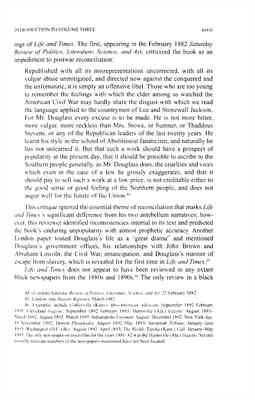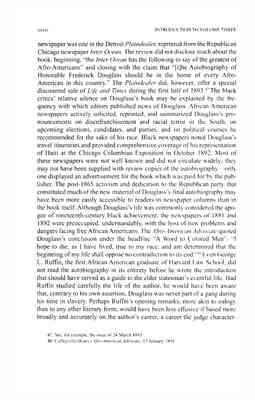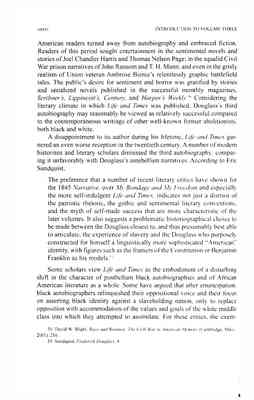Pages
21
INTRODUCTION TO VOLUME THREE xxxiii
ings of Life and Times. The first, appearing in the February 1882 Saturday Review of Politics, Literature, Science, and Art, criticized the book as an impediment to postwar reconciliation:
Republished with all its misrepresentations uncorrected, with all its vulgar abuse unmitigated, and directed now against the conquered and the unfortunate, it is simply an offensive libel. Those who are too young to remember the feelings with which the elder among us watched the American Civil War may hardly share the disgust with which we read the language applied to the countrymen of Lee and Stonewall Jackson. For Mr. Douglass every excuse is to be made. He is not more bitter, more vulgar, more reckless than Mrs. Stowe, or Sumner, or Thaddeus Stevens, or any of the Republican leaders of the last twenty years. He learnt his style in the school of Abolitionist fanaticism, and naturally he has not unlearned it. But that such a work should have a prospect of popularity at the present day, that it should be possible to ascribe to the Southern people generally, as Mr. Douglass does, the cruelties and vices which even in the case of a few he grossly exaggerates, and that it should pay to sell such a work at a low price, is not creditable either to the good sense or good feeling of the Northern people, and does not augur well for the future of the Union.44
This critique ignored the essential theme of reconciliation that marks Life and Times's significant difference from his two antebellum narratives; however, this reviewer identified inconsistencies internal to its text and predicted the book's enduring unpopularity with almost prophetic accuracy. Another London paper touted Douglass's life as a "great drama" and mentioned Douglass's government offices, his relationships with John Brown and Ahraham Lincoln, the Civil War, emancipation, and Douglass's manner of escape from slavery, which is revealed for the first time in Life and Times.45
Life and Times does not appear to have been reviewed in any extant black newspapers from the 1880s and 1890s.46 The only review in a black
4444 (London) Saturday Review of Politics, Literature, Science, and Art, 25 February 1882.
4545. London Anti-Slavery Reporter, March 1882.
4646. Examples include Coffeyville (Kans.) Afro-American Advocate, September 1892–February 1893; Cleveland Gazette, September 1892–February 1893; Huntsville (Ala,) Gazette, August 1881– March 1882, August 1892–March 1893; Indianapolis Freeman, August–December 1892; New York Age, 19 November 1892; Detroit Plaindealer, August 1892-May 1893; Savannah Tribune, January–June 1893; Washington (D.C.) Bee, August 1892–April 1893; The Weekly Topeka (Kans.) Call, January–May 1893. The only newspaper on microfilm for the years 1881–82 was the Huntsville (Ala.) Gazette. Several possiby relevant numbers of the newspapers mentioned have not been located.
22
xxxiv INTRODUCTION TO VOLUME THREE
newspaper was one in the Detroit Plaindealer, reprinted from the Republican Chicago newspaper Inter Ocean. The review did not disclose much about the book, beginning, "the Inter Ocean has the following to say of the greatest of Afro-Americans" and closing with the claim that "[t]he Autobiography of Honorable Frederick Douglass should be in the home of every AfroAmerican in this country." The Plainedealer did, however, offer a special discounted sale of Life and Times during the first half of 1893.47 The black critics' relative silence on Douglass's book may be explained by the frequency with which editors published news of Douglass. African American newspapers actively solicited, reprinted, and summarized Douglass's pronouncements on disenfranchisement and racial terror in the South, on upcoming elections, candidates, and parties, and on political courses he recommended for the sake of his race. Black newspapers noted Douglass's travel itineraries and provided comprehensive coverage of his representation of Haiti at the Chicago Columbian Exposition in October 1892. Most of these newspapers were not well known and did not circulate widely; they may not have been supplied with review copies of the autobiography—only one displayed an advertisement for the book which was paid for by the publisher. The post-1865 activism and dedication to the Republican party that constituted much of the new material of Douglass's final autobiography may have been more easily accessible to readers in newspaper columns than in the book itself. Although Douglass's life was commonly considered the apogee of nineteenth-century black achievement, the newspapers of 1881 and 1892 were preoccupied, understandably, with the host of new problems and dangers facing free African Americans. The Afro-American Advocate quoted Douglass's conclusion under the headline "'A Word to Colored Men'": "I hope to die, as I have lived, true to my race, and am determined that the beginning of my life shall oppose no contradiction to its end."48 Even George L. Ruffin, the first African American graduate of Harvard Law School, did not read the autobiography in its entirety before he wrote the introduction that should have served as a guide to the elder statesman's eventful life. Had Ruffin studied carefully the life of the author, he would have been aware that, contrary to his own assertion, Douglass was never part of a gang during his time in slavery. Perhaps Ruffin's opening remarks, more akin to eulogy than to any other literary form, would have been less effusive if based more broadly and accurately on the author's career, a career the judge character-
4747. See, for example, the issue of 24 March 1893.
4848. Coffeyville (Kans.) Afro-American Advocate, 13 January 1893.
23
INTRODUCTION TO VOLUME THREE xxxv
izes as having reached its triumphant conclusion in the Emancipation Proclamation. For a new generation of African American activists, Douglass's moment had passed even as his example continued to be revered.
Negative reviews aside, the length of Life and Times—more than 500 pages in 1881—prohibited the type of dramatic reading experience afforded by Douglass's concise Narrative. A reading of Life and Times from start to finish reveals a pastiche of inconsistencies and interpolations—puzzles difficult for a casual reader of the autobiography to unravel without access to the many primary sources Douglass imported, improved, and combined from his other writings, both published and unpublished. Ironically, the multiple foci of the third autobiography relative to the clear agenda driving Douglass's antebellum narratives constitute its unique historical value. Similarly, its inconsistencies and apparent errors reveal the internal life and thought processes of the author in ways that the earlier, more carefully written autobiographies cannot. Narrative and, to a lesser extent, My Bondage and My Freedom were and continue to be considered the most powerful, moving examples of the antebellum slave narrative. In contrast, Life and Times has since its first appearance in print proven cumbersome and difficult for the most knowledgeable students of Douglass and of nineteenth-century America to characterize or categorize.
The relative paucity of reviews for Life and Times and its sales figures, disappointing when compared to those of Douglass's earlier autobiographies, reflect a broad trend in American print media after 1865. Other postbellum autobiographies and memoirs—those by former slaves, free blacks, as well as former abolitionists, black and white—were unable to spark the interest of a readership that was exhausted by a devastating war, the failed attempt at Reconstruction, upheavals in party politics, and the escalating racist violence that followed slavery's abolition. As Julie Roy Jeffrey documents in her 2008 study of postbellum abolitionist memoirs, the giddy sense of accomplishment that emancipation provided opponents of slavery was short-lived. The leading monthlies of the period, widely circulated, well funded, and powerful in their ability to shape public sentiment, advocated and published conciliatory viewpoints in their editorials, serializations, poetry, and short stories. In 1874, for example, Josiah Holland, editor of Scribner's, recommended that the U.S. government endeavor to placate the southern whites in order to "reclaim their affectionate loyalty" rather than wounding former Confederates further by imposing an unduly harsh Reconstruction program.49 During the final quarter of the nineteenth century,
4949. Jeffrey, Abolitionists Remember, 2.
24
xxxvi INTRODUCTION TO VOLUME THREE
American readers turned away from autobiography and embraced fiction. Readers of this period sought entertainment in the sentimental novels and stories of Joel Chandler Harris and Thomas Nelson Page; in the squalid Civil War prison narratives of John Ransom and T. H. Mann; and even in the grisly realism of Union veteran Ambrose Bierce's relentlessly graphic battlefield tales. The public's desire for sentiment and horror was gratified by stories and serialized novels published in the successful monthly magazines, Scribner's, Lippincott's, Century, and Harper's Weekly.50 Considering the literary climate in which Life and Times was published, Douglass's third autobiography may reasonably be viewed as relatively successful compared to the contemporaneous writings of other well-known former abolitionists, both black and white.
A disappointment to its author during his lifetime, Life and Times garnered an even worse reception in the twentieth century. A number of modern historians and literary scholars dismissed the third autobiography, comparing it unfavorably with Douglass's antebellum narratives. According to Eric Sundquist,
The preference that a number of recent literary critics have shown for the 1845 Narrative, over My Bondage and My Freedom and especially the more self-indulgent Life and Times, indicates not just a distrust of the patriotic rhetoric, the gothic and sentimental Iiterary conventions. and the myth of self-made success that are more characteristic of the later volumes. It also suggests a problematic historiographical choice to be made between the Douglass closest to, and thus presumably best able to articulate, the experience of slavery and the Douglass who purposely constructed for himself a linguistically more sophisticated "American" identity, with figures such as the framers of the Constitution or Benjamin Franklin as his models.51
Some scholars view Life and Times as the embodiment of a disturbing shift in the character of postbellum black autobiographies and or African American literature as a whole. Some have argued that after emancipation, black autobiographers relinquished their oppositional voice and their focus on asserting black identity against a slaveholding nation, only to replace opposition with accommodation of the values and goals of the white middle class into which they attempted to assimilate. For these critics, the exem-
5050. David W. Blight, Race and Reunion: The Civil War in American Memory (Cambridge, Mass., 2001), 216.
5151. Sundquist, Frederick Douglass, 4.
25
INTRODUCTION TO VOLUME THREE xxxvii
plary black autobiography of the era was Booker T. Washington's Up from Slavery (1901). Washington argued the utility of including American blacks thoroughly in the nation's fabric and saw little value for black Americans in the search for and assertion of some distinctive African American identity. Some scholars assert that African Americans would not really resume the quest to define their identity until the establishment of Marcus Garvey's United Negro Improvement Association and the rise of the New Negro artistic movement in the 1920s. As Sundquist points out in a review of Dickson Bruce's Black American Writing from the Nadir: Evolution of a Literary Tradition, 1877–1915, "the central issue for African-American writers of the era was the discovery of a voice and a vocabulary for articulating black identity within, not outside of, the mainstream of genteel culture."52 In this context, Wilson J. Moses contends that, "[w]ith slavery dead, [Douglass] was unable to construct a public role that spoke adequately to the problems of Reconstruction.... The enduring popularity of Frederick Douglass derives far more from the brilliance of his anti-slavery career than from the clarity of his postbellum vision."53 Henry Louis Gates and Charles Davis write that the confrontational, resolute black voice was suppressed or altogether abandoned in the face of the daunting problems and confusions of postemancipation freedom: "With the end of slavery... the black seems to have lost his great, unique theme until Jim Crow racism and segregation recreated it. The stilling of the black "voice" assumed myriad forms, not the least distressing of which was the effective destruction of black arts and letters existing before 1865.... Essentially, the slave narrative proper could no longer exist after slavery was abolished."54 While Gates is undoubtedly aware of the large number of black autobiographies produced between 1865 and 1900, the generic expectations of these autobiographies altered drastically, as did, accordingly, the black autobiographical form itself.55 For these scholars, Douglass's narratives and black autobiography in general had lost their noble social missions after 1865.
There can be no question that the thrust of these autobiographies shifted after the Civil War as authors abandoned the theme of the broad pursuit of freedom as an absolute good and focused instead on a complex interrogation of the character and limits of the recently secured freedom. William Andrews
5252. Review by Eric J. Sundquist in Nineteenth-Century Literature, 45:106 (June 1990).
5353. Review by Wilson J. Moses in African American Review, 30:302 (Summer 1996).
5454. Charles T. Davis and Henry Louis Gates, Jr., eds., The Slave's Narrative (New York, 1985), xviii
5555. Ibid., xxii–xxiii.




